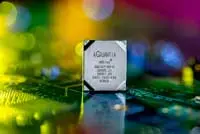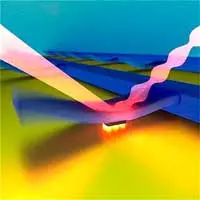Electronics News
Archive : 19 December 2016 год
 The AQtion product line of multi-gigabit Ethernet BASE-T controllers developed by Aquantia support 10,5 and 2.5Gbit speeds in addition to Gigabit Ethernet.
The AQtion product line of multi-gigabit Ethernet BASE-T controllers developed by Aquantia support 10,5 and 2.5Gbit speeds in addition to Gigabit Ethernet.
“We are now delivering the last piece of the puzzle in enterprise and SMB networks: the multi-gigabit client connectivity,” said Kamal Dalmia, vice president, sales and marketing, Aquantia.
According to the company, Gigabit Ethernet, which has been in the market for more than 15 years, is running out of steam. Applications such as video editing, image rendering, large database transfers, multi-core simulations and Enterprise-class backup relying on data stored in local Network-Attach Storage (NAS) for example, are placing constraints on legacy gigabit Ethernet connectivity.
AQtion is an Enterprise-class client controller technology supporting Multi-Gigabit speeds. The AQtion devices, the AQC107 and the AQC108, support 5 and 2.5Gbit Ethernet over copper, or 2.5/5GBASE-T. The devices are compliant with the NBASE-T specification and the IEEE 802.3bz standard.
In addition, both devices also support backward compatibility with 100MbE and Gigabit Ethernet. The AQC107 has the extra feature of supporting up to 10Gbit Ethernet, or 10GBASE-T, on Cat6A copper cables, complying with the IEEE802.3an.
Both devices are single port and support four speeds:100M/1G/2.5G/5G Ethernet, with the AQC107 also supporting 10G Ethernet.
Client machines adopting Aquantia’s AQtion controllers will be able to connect to an array of Ethernet switches that have already entered the market with multi-gig ports, as well as to the latest generation of WiFi 802.11ac access points.
Author
Peggy Lee
Source: www.newelectronics.co.uk
 A device developed by scientists at the National Institute of Standards and Technology (NIST) can measure the motion of nanoparticles traversing distances shorter than the diameter of a hydrogen atom.
A device developed by scientists at the National Institute of Standards and Technology (NIST) can measure the motion of nanoparticles traversing distances shorter than the diameter of a hydrogen atom.
"We can detect tiny motion more locally and precisely with these plasmonic resonators than any other way of doing it," said NIST physicist Vladimir Aksyuk.
Applications include sensing trace amounts of hazardous biological or chemical agents; perfecting the movement of miniature robots; accurately deploying airbags; and detecting weak sound waves travelling through thin films.
According to Aksyuk, interaction between the device’s laser light and the plasmons is critical for sensing tiny displacements from nanoscale particles.
With the right choice of wavelength, the laser light causes plasmons of a particular frequency to resonate along a small air gap.
Meanwhile, as the nanoparticle moves, it changes the width of the gap and the frequency at which the plasmons resonate.
Light can't easily detect the location or motion of an object smaller than the wavelength of the laser, but converting the light to plasmons overcomes this limitation. Because the plasmons are confined to a gap, they are more sensitive than light for sensing the motion of small objects.
The amount of reflected laser light reveals the width of the gap and the motion of the nanoparticle.
Author
Peggy Lee
Source: www.newelectronics.co.uk
Researchers from Harvard’s School of Engineering and Applied Sciences have used atomic scale defects in pink diamonds to create the world’s smallest radio receiver.
Featuring building blocks the size of two atoms, the radio can withstand harsh environments and is biocompatible. “Diamonds have unique properties,” said Professor Marko Loncar. “This radio would be able to operate in space, in harsh environments and even the human body, as diamonds are biocompatible.”
The radio uses imperfections in diamonds called nitrogen vacancy (NV) centres. To make them, researchers replace one carbon atom in a diamond crystal with a nitrogen atom, then remove a neighbouring atom. This creates a system featuring a nitrogen atom with a hole next to it. NV centres, which can emit single photons or detect very weak magnetic fields, also have photoluminescent properties, meaning they have potential application in quantum computing, phontonics and sensing.
In the Harvard device, electrons in diamond NV centres are pumped by green light emitted from a laser. When the NV centre receives radio waves, it converts them and emits the audio signal as red light. A photodiode converts light into a current, which is converted to sound through a simple speaker.
The tuning frequency of the NV centre can be changed using an electromagnet.
Prof Loncar and graduate student Linbo Shao used billions of NV centres in order to boost the signal, but say the radio can work with a single NV centre, emitting one photon at a time, rather than a stream of light.
And, because of the inherent strength of diamond, the team played music successfully at 350°C.
Author
Graham Pitcher
Source: www.newelectronics.co.uk
Optical fibre sensing shows promise for monitoring the condition of structures. By embedding long optical fibres into a structure, strain and temperature distributions along the fibres can be detected. Until now, however, time of distributed measurement took from several tens of seconds to several minutes.
Now, a team from the Tokyo Institute of Technology and the University of Tokyo has increased the sampling rate by more than 5000 times, which enables real-time distributed measurement.
The approach uses BOCDR – Brillouin optical correlation-domain reflectometry – which is a distributed sensing technique with high spatial resolution, high sensitivity and stability.
In all Brillouin sensors, the strain and temperature dependence of the Brillouin frequency shift (BFS) is exploited to derive strain and temperature. In conventional BOCDR, the BFS is obtained by performing a frequency sweep over the whole Brillouin gain spectrum (BGS) using an electrical spectrum analyser. The sweep speed of the spectrum analyser limits the sampling rate to 19Hz.
By sweeping the frequency spectrum using a voltage-controlled oscillator, the researchers were able to achieve a higher speed acquisition. However, deriving the BFS from the BGS still limited the sampling rate. To speed up the system further, the BGS was converted into a synchronous sinusoidal waveform using a band-pass filter, allowing the BFS to be expressed as its phase delay. Then, using an exclusive-OR logic gate and a low-pass filter, the phase delay was subsequently converted into a voltage, which was directly measured.
The sensing system also has potential applications in robotics – acting as electronic ‘nerves’ for detecting touch, distortion, and temperature change.
Author
Peggy Lee
Source: www.newelectronics.co.uk
